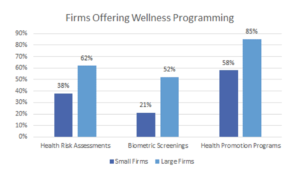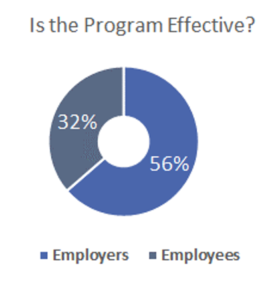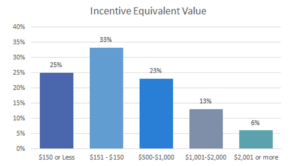Human Capital
A component of the Holistic Wellbeing Approach, physical wellness is about individuals practicing behaviors that support the physical body including health and safety. This is the classically defined wellness program that attempts to modify lifestyle and behavioral components by promoting proper care of our bodies. Specific attributes typically have included behavior changes with tobacco use, body mass index or BMI management, and chronic disease management.
A tremendous amount of research within the wellness industry has been conducted and reported on regarding the correlation between a physically fit individual and job productivity. To set the stage though, let us remind ourselves that for employers productivity losses linked to employees who miss work cost employers $225.8 billion or $1,685 per employee each year, according to the Center for Disease Control (CDC). Additionally, it would be important to highlight a couple of points.
- First, health plans and Federal and State regulations have evolved to recognize the importance of physical wellness. For example, within the Affordable Care Act (ACA), wellness and prevention benefits are mandated and reimbursed at no cost to the employee and their dependents.
- Second, the employer has costs that are independent of one another and attempting to bring solutions across all the different expense lanes is a challenge. For example, a client might implement a disease management program across its employee benefits program only to see its costs in worker’s compensation, disability programs, or leave of absence programs related to Family and Medical Leave Act claims rise.
- Third, several other wellness components “overlap” with physical well-being. For example, individuals with both depression and a major chronic illness consume nearly twice the health resources as individuals with a major chronic illness alone. Additionally, stress caused by financial and other issues is well-documented to cause or worsen health conditions. And, finally, biologically-based mental illnesses can result in dysfunction in other areas (most prominently, financial, emotional, and social well-being) that impact productivity. Because of this, the most effective holistic wellness programs try to embed communication processes across vendors (for example the carrier of TPA, health management program vendors, and EAP vendors).
Physical wellness programming has three components: Health Risk Assessments, Biometric Screening Programs, and Health Promotion activities (this component includes a broad range of programming such as: Challenges (exercise or weight), Lifestyle Coaching, and Disease Management).
Most large firms (> 200 employees) and many small firms offer these types of programs:

(Source: Kaiser/HRET Survey of Employer-Sponsored Health Benefits, 2017)
Health Risk Assessments are intended to identify health and behavioral issues that are not identifiable through other methods and to provide personally reported insight into the validity of some risk factors identified through biometric screening or preventive physician exams. One important aspect of well-designed HRAs is that they provide an index of a participant’s “readiness to change”. If readiness to change is lacking, health promotion programs will be ineffective.
Biometric screenings identify health risks that are biologically measurable, thus avoiding accuracy issues that are an intrinsic part of self-reporting. However, Biometric Screening does not address readiness to change. Because of this, some believe that incentivizing preventive care physician visits may be more effective.
Health Promotion Programs are meant to address issues identified through HRAs, Biometric Screening or claims data. These programs originated as health plan add-ons; more recently, third-party vendors have entered the market because plan sponsored health promotion programming has been ineffective, primarily because of low engagement rates (5% – 10%).
Not surprisingly, there is a significant difference of opinion, between employers and employees, regarding the effectiveness of physical wellness programming.

Source: Willis Towers Watson Best Practices in Employer Health Care Employer Survey, 2017
What is effectiveness? From an employer’s point of view, effectiveness usually means improved productivity and decreased health and disability plan costs. From an employee’s point of view, effectiveness means improved health and/or reduced health risks.
In either case, program effectiveness depends on three critical factors: A supportive company culture, availability of user-friendly effective program components and employee engagement. Culture and programming are best addressed through the development and implementation of a comprehensive wellness plan; however, only 44% of firms have a health and well-being strategy in place (Source: Willis Towers Watson Best Practices in Employer Health Care Employer Survey, 2017).
Employee engagement is critical and can also be addressed through a wellness plan, but the results have been mixed. For example, 87% of employers intend to make employee engagement a top priority over the next three years, but only 32% report having made progress toward improving engagement over the past two years (Source: Willis Towers Watson Best Practices in Employer Health Care Employer Survey, 2017).
Employers increasingly believe that incentives for member engagement and ongoing program participation should be an intrinsic part of any physical wellness program. 32% of firms now offer financial incentives for engagement and participation in Health Promotion programs. The amount and type (for example, gift cards, access to less costly plan design, or an HSA contribution) vary, but the incentives are usually significant.

(Source: Kaiser/HRET Survey of Employer-Sponsored Health Benefits, 2017)
Willis Towers Watson has identified three best practices of companies achieving competitive advantage through health plan cost reduction and efficiency (Source: Willis Towers Watson Best Practices in Employer Health Care Employer Survey, 2017). They are:
- Assessing the work environment and physical wellness programming and aligning them with company culture;
- Focusing on programs that target a few high-cost conditions; and,
- Engaging employees through financial incentives and company social networks.
Related:
-
Heat-Related Worker Deaths Surge as Construction Industry Faces Mounting Crisis
- A Lot To Be Stressed Out About: Psychological Safety in the Workplace
- Skills-based hiring: Focus on abilities, not degrees, says HIRE Initiative
- PTO – One of the Most Desired Benefits
- Unconscious Bias: A Reality of the Truth




